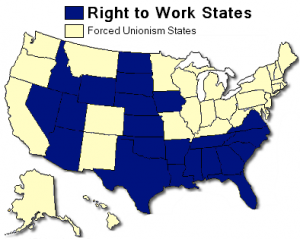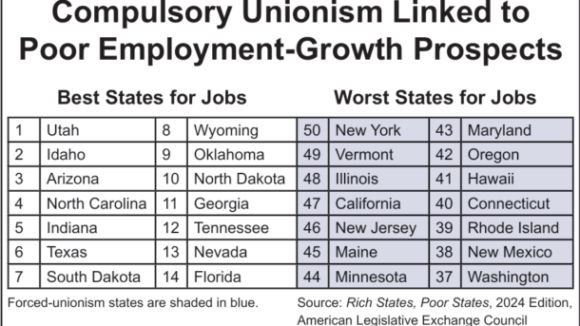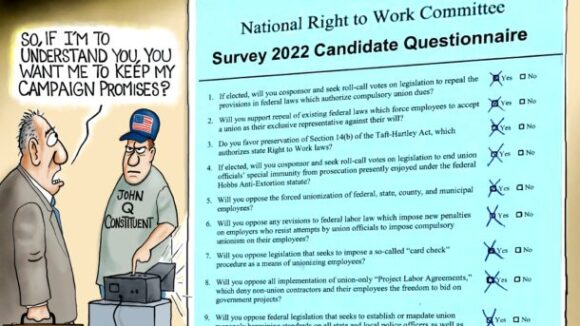Is This Any Way to Run a City’s Schools?
Leaked CTU Proposals Won’t Do Anything to Improve Schools’ Poor Performance
Eminent Economist Gauges Benefits of Banning Forced Unionism
(Source: March 2010 NRTWC Newsletter)
A new scholarly article by eminent economist Richard Vedder constitutes an important addition to the already formidable array of evidence that state Right to Work laws increase job opportunities and raise employees’ real incomes.
Dr. Vedder, a professor on the faculty of Ohio University in Athens, Ohio, and the author of more than 100 academic papers published in scholarly journals as well as several books, is a specialist in labor, taxation and education issues.
With fellow Ohio University economist Lowell Galloway, Dr. Vedder is the coauthor of the acclaimed book Out of Work, an examination of the ties between unemployment and public policies in 20th Century America.
In 1994, this book was both the recipient of the Sir Anthony Fisher International Memorial Award and a Mencken Award Finalist.
In “Right to Work Laws: Liberty, Prosperity, and Quality of Life,” an article appearing in the Winter 2010 edition of Cato Journal, Dr. Vedder observes that currently 22 states have on the books Right to Work laws banning the termination of employees for refusal to join or pay dues or fees to an unwanted union.
Massive Migration to Right to Work States an ‘Important Untold Story’
An “important untold story,” Dr. Vedder continues, “is the rapid growth of population” living in Right to Work states “relative to states refusing to grant workers the right to reject unionization.”
In 1970, 28.5% of Americans lived in Right to Work states. By 2008, the “proportion” had risen to nearly 40%, or over 121 million people.
And “the most important reason for the increase in the percentage of the U.S. population” living in Right to Work states has been “a huge migration of persons” from forced-unionism states “to those allowing greater personal liberty with respect to employment.”
U.S. Census Bureau estimates indicate that, from April 1, 2000 to July 1, 2008, a net total of roughly 4.7 million Americans, “on average more than one person every single minute,” moved from a forced-unionism state to a Right to Work state.
Dr. Vedder goes on to summarize a multiple regression analysis he did to determine whether some factor other than the lack of Right to Work protections could possibly account for the massive and continuing out-migration from forced-unionism states.
Analysis Reinforces ‘View That People Vote With Their Feet’ For Right to Work
“I tried several different models,” he reports, “incorporating different sets of explanatory variables (tax, climate, occupational composition of the labor force, unemployment, [and] population density . . .).
“Without exception, in all the estimations, a statistically significant positive relationship . . . was observed between the presence” of a Right to Work law “and net migration. . . .
“Consider a state with a population of five million in 2000. Other things equal, the model with the best predictive power that we used suggests that about 150,000 more people would move into the state between 2000 and 2008” because of its Right to Work status.”
Overall, Dr. Vedder’s findings “reinforce the view that people vote with their feet to move to freer labor market environments.”
Elsewhere in the article, Dr. Vedder reports that he also did a regression analysis “to relate the rate of growth in real personal per capita personal income from 1977 to 2007 for the 48 contiguous U.S. states to the existence” of Right to Work laws.
The analysis controlled for each state’s tax burden, the share of its adults with college degrees, land area, and several other variables.
Right to Work Law ‘Would Have Increased Per Capita Income by an Extra $2760’
Here again, Dr. Vedder found “a very strong and highly statistically significant . . . positive relationship between” Right to Work laws and economic growth.”
He elaborates: Suppose two states both “had per capita income of $24,000 in 1977.”
Real per capita income in the state without Right to Work protections “would have risen to $36,000 in 2007, compared to $38,760” in the Right to Work state. Right to Work protections “would have increased per capita income by an extra $2760 — or over $11,000 annually for a family of four.”
While alternative models “might offer somewhat different conclusions, . . . based on existing evidence, a strong case can be made” that Right to Work laws “have a positive impact on U.S. living standards.”
But despite all the evidence of Right to Work laws’ economic benefits, and despite the fact that nearly 80% of Americans who regularly vote support the Right to Work as a matter of principle, passing a state Right to Work law is never easy.
Unions that file federal disclosure forms rake in a total of roughly $20 billion a year in (mostly forced) dues and fees, government grants, rents, interest, and other revenues. And union bosses deploy a huge share of that money on politics and lobbying.
Freedom-Loving Citizens Must Be Mobilized to Pass More Right to Work Laws
As Dr. Vedder notes, most politicians fear the power of the Big Labor lobby, “but . . . probably also suspect that public opinion is generally supportive” of Right to Work laws.
Many politicians evidently calculate that these factors “are roughly offsetting, so the politically optimal thing to do is nothing: don’t rock the boat.”
“Though Richard Vedder is an economist, not a political scientist, his analysis of the way many politicians think is right on target,” commented National Right to Work Committee President Mark Mix.
“That’s why it takes several years of painstaking mobilization by freedom-loving citizens to put sufficient pressure on state legislators and executives to adopt and sign into law a Right to Work measure banning forced union dues.
“But the vital protections such laws furnish for personal freedom and the economic dynamism they make possible are always well worth the effort.
“And the Committee and its 2.5 million members and supporters always stand ready to offer our advice and assistance for citizens in any of the 28 current forced-unionism states who are willing to take on the fight to bring about passage of new Right to Work laws.
“Moreover, the Committee also continues to work for passage of national Right to Work legislation repealing all federal labor-law provisions that authorize forced union dues and fees. Effectively, that would make all 50 states Right to Work states.”

Leaked CTU Proposals Won’t Do Anything to Improve Schools’ Poor Performance

Wherever Big Labor wields the power to collect forced union dues, union bosses funnel a large share of the confiscated money into efforts to elect and reelect business-bashing politicians. Employment growth tends to lag as a consequence.

Members Insist They Keep Pro-Right to Work Campaign Promises